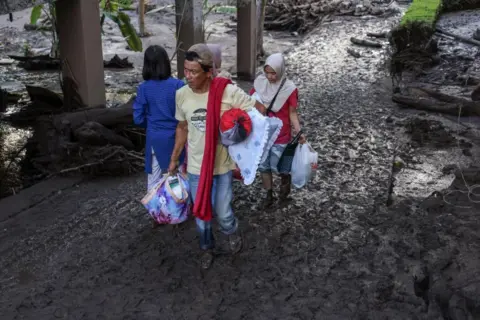At least 37 people were killed after flash floods and cold lava flowing from a volcano hit the western Indonesian island of Sumatra.
Hours of heavy rain on Saturday swept torrents of ash and rocks down Mount Marapi, the most active volcano in Sumatra.
The cold lava mudslides inundated two districts, swept people to their deaths and damaged more than 100 homes, mosques and public facilities.
Authorities say the death toll could increase given 18 people are missing.
Survivors recounted how they fled as the cold lava - a mixture of volcanic material and pebbles that flow down a volcano's slopes in the rain - flowed towards their homes.
"I heard the thunder and the sound similar to boiling water. It was the sound of big rocks falling from Mount Marapi,” Rina Devina, a 43-year-old housewife from the Agam district told AFP news agency.
“It was pitch black, so I used my cellphone as a torch. The road was muddy, so I chanted ‘God, have mercy’ over and over again,” Ms Devina said.
The mother of three added that a neighbour's house had been "flattened by big rocks" and four of her neighbours died.
By Sunday afternoon, rescuers had found 19 bodies in the worst-hit village of Canduang in Agam district and recovered nine other bodies in the neighbouring district of Tanah Datar, according to the National Search and Rescue Agency.
Berliana Reskyka, another Agam resident, spoke of his experiences helping his injured neighbours.
"There were some who were crying, hysterical, because some of their family members were not yet accounted for. There were also those who discovered their loved ones have died," Berliana told BBC Indonesian.

The deluge is the latest in a series of natural disasters that have resulted, at least in part, from human activities, environment experts told BBC Indonesian.
"Flash floods and cold lava mudslides continue to recur and increase in intensity due to excessive exploitation of natural resources and haphazard development," said Wengki Purwanto, the director of the West Sumatra branch of the Indonesian Forum for Environment.
"As a result, disasters repeat themselves every year. In fact, they increase in frequency every year. The distance between one disaster and the next becomes closer," he said.
The area around Mount Marapi has seen several similar disasters in the past six months.
Last 5 December, 23 hikers were killed when the volcano erupted while in February this year, flash floods damaged dozens of homes in the Tanah Datar.
Just last month, days of eruption threw huge clouds of ash - up to a height of 2km - into the sky. Flights in the region were disrupted, roads closed, and more than 11,000 people were told to evacuate.
Marapi translates from the local Minang language to "Mountain of Fire".

Latest Stories
-
Peru’s ex-president and first lady sentenced to 15 years in jail
3 minutes -
Suit against CJ’s removal: Mahama is performing his constitutional duty – Ayine replies Dame
7 minutes -
Parliament’s Trade Committee promises more tax waivers for industries to support job creation agenda
7 minutes -
You are the architects of our digital future – Mahama tells Ghanaian youth as he launches One Million Coders programme
11 minutes -
1 Million Coders initiative to give equal digital opportunities – Sam George
14 minutes -
Oh Joo champions autism awareness with Turd Talks on April 19
15 minutes -
Harvard just stood up to Trump. How long can it last?
22 minutes -
AGI to launch website, fund to promote tourism sector in Volta Region
24 minutes -
GPL 2024/25: Basake Holy Stars aim to bounce back against Vision FC
26 minutes -
UK and France in talks over migrant returns deal
27 minutes -
UK Supreme Court backs ‘biological’ definition of woman
34 minutes -
Nii Noi describes Dag Heward-Mills’ comments on not paying church musicians as unfortunate
35 minutes -
Photos: Illegal miners invade Tano Anwia forest reserve again
38 minutes -
Local Investors expressed interest in Ghana’s iron ore sector – GIISDEC
42 minutes -
Sincerity, Friendship and Equality: Written in An Era of Global Economic Turbulence
48 minutes

